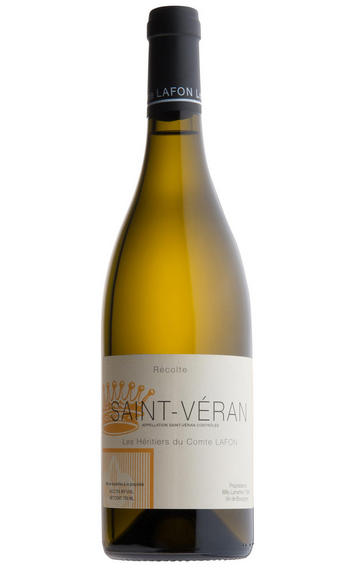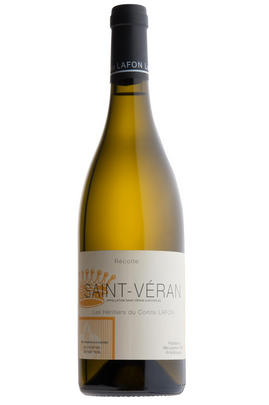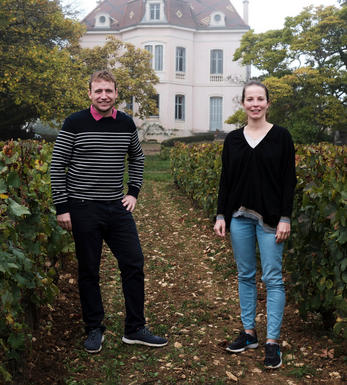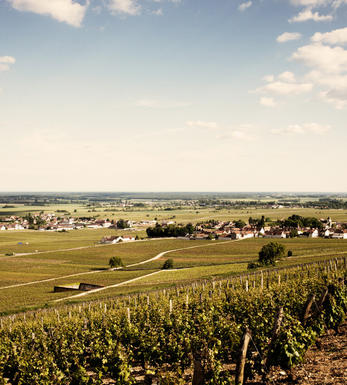
2020 St Véran, Les Héritiers du Comte Lafon, Burgundy

Critics reviews
Neal Martin, Vinous (December 2021)
This is a wine of impressive balance and length, produced from a number of parcels spread over nearly 2ha in Prissé and Davayé that ripen grapes early, yet the fruit has retained a lively acidity. Fermentation is done in a combination of large oak uprights and neutral demi-muids in order to maintain the purity of fruit, with alcohol kept at a modest (for the vintage) 12.5-13%.
Drink 2022 - 2035
Charles Curtis MW, Decanter.com (Oct 2021)
About this WINE

Heritiers du Comte Lafon
Les Héritiers du Comte Lafon was established in 1999 when the famed Lafon family of Meursault purchased a small domaine in Milly-Lamartine.
Their enthusiasm for the project has grown ever since, as has the domaine: today it covers 26 hectares in the most prestigious appellations of the Mâconnais, all farmed biodynamically.
The estate is overseen by the energetic Caroline Gon, in close consultation with Dominique Lafon. The 2020 vintage sees the increased involvement of Dominique’s daughter Léa and nephew Pierre, both taking a keen interest in the Mâconnais project.
Caroline continues to run the estate on a day-to-day basis, putting Dominique’s vision into practice.
In the winery
Vinification and ageing continue to move towards larger oak formats, with increased use of foudres and demi-muids. The team recognise the profile of Mâcon wines as being more generous and fruitier than those of the Côte d’Or. So their aim is to retain as much freshness as possible, and not to impart too much oak character.

Saint-Véran
Saint-Véran is the southernmost appellation of the Mâconnais region of Burgundy, and consists of two areas, divided by the lands of Pouilly-Fuissé, that produce a dry white wine. Named after the town of Saint-Vérand which is included inside its jurisdiction, an administrative error in 1971, the year of the formation of the AOC, meant that Saint-Véran lost the‘d’ at the end of its name.
Saint-Véran produces both white and red wines, but due to its unique position as the most southern appellation of Burgundy, it technically overlaps into the northern boundary of Beaujolais, meaning that some of its communes produce reds to be sold as Beaujolais Cru, but whites to be sold as Burgundian, due to the inferred superiority over the more generic Beaujolais Blanc AOC.
Saint-Véran whites are generally well-regarded amongst the wine community, indeed their qualities were realised prior to its official classification as an appellation in 1971 by many aficionados.
They are all made from Chardonnay variety in the customary Burgundy fashion, but are known to be slightly more full-bodied than other varieties of white Burgundy. Notable changes occur during aging: Saint-Véran whites go from a floral and fruity youth to a nuttier and honeyed maturity. As with many wines from the Mâconnais region they also often display notes of minerality, something which is greatly desired.

Chardonnay
Chardonnay is often seen as the king of white wine grapes and one of the most widely planted in the world It is suited to a wide variety of soils, though it excels in soils with a high limestone content as found in Champagne, Chablis, and the Côte D`Or.
Burgundy is Chardonnay's spiritual home and the best White Burgundies are dry, rich, honeyed wines with marvellous poise, elegance and balance. They are unquestionably the finest dry white wines in the world. Chardonnay plays a crucial role in the Champagne blend, providing structure and finesse, and is the sole grape in Blanc de Blancs.
It is quantitatively important in California and Australia, is widely planted in Chile and South Africa, and is the second most widely planted grape in New Zealand. In warm climates Chardonnay has a tendency to develop very high sugar levels during the final stages of ripening and this can occur at the expense of acidity. Late picking is a common problem and can result in blowsy and flabby wines that lack structure and definition.
Recently in the New World, we have seen a move towards more elegant, better- balanced and less oak-driven Chardonnays, and this is to be welcomed.


Buying options
Add to wishlist
Description
From parcels in Davayé (bought in 2014) and Prissé (’16), this recent addition to the stable has responded well the Lafon viticulture. It gains in tension and precision with each passing year. There is a pleasing marriage of freshness and opulence which results in a complex and expressive wine. Drink 2022-2030.
wine at a glance
Delivery and quality guarantee